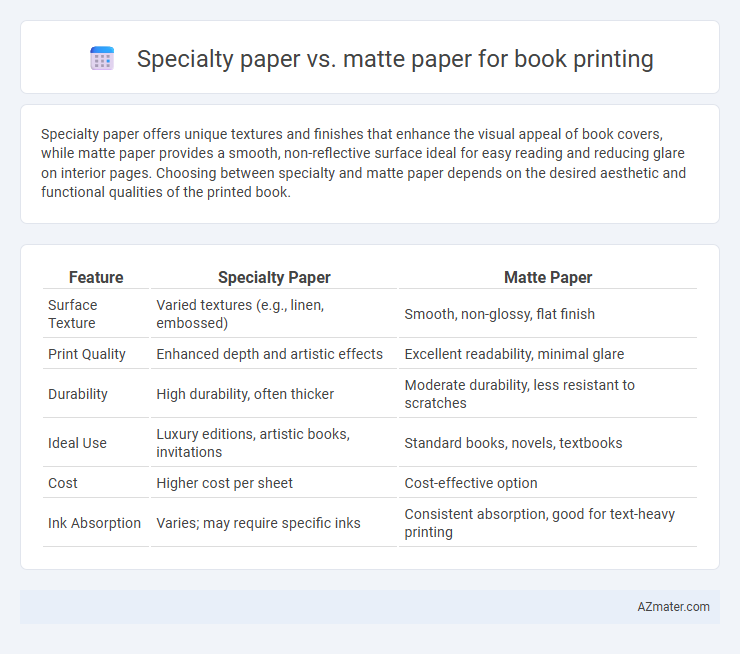Specialty paper offers unique textures and finishes that enhance the visual appeal of book covers, while matte paper provides a smooth, non-reflective surface ideal for easy reading and reducing glare on interior pages. Choosing between specialty and matte paper depends on the desired aesthetic and functional qualities of the printed book.
Table of Comparison
| Feature | Specialty Paper | Matte Paper |
|---|---|---|
| Surface Texture | Varied textures (e.g., linen, embossed) | Smooth, non-glossy, flat finish |
| Print Quality | Enhanced depth and artistic effects | Excellent readability, minimal glare |
| Durability | High durability, often thicker | Moderate durability, less resistant to scratches |
| Ideal Use | Luxury editions, artistic books, invitations | Standard books, novels, textbooks |
| Cost | Higher cost per sheet | Cost-effective option |
| Ink Absorption | Varies; may require specific inks | Consistent absorption, good for text-heavy printing |
Introduction to Specialty Paper vs Matte Paper
Specialty paper offers unique textures, finishes, and enhanced durability ideal for premium book printing projects, providing a distinct tactile experience and visual appeal. Matte paper, characterized by its non-glossy, smooth surface, reduces glare and improves readability, making it optimal for text-heavy books and long-form reading. Selecting between specialty and matte paper depends on the desired aesthetic, tactile quality, and functional purpose of the printed book.
Defining Specialty Paper in Book Printing
Specialty paper in book printing refers to premium-grade materials with unique textures, finishes, or compositions designed to enhance the tactile and visual experience, such as linen, laid, or metallic finishes. Unlike standard matte paper, specialty paper often features distinct qualities like higher opacity, durability, and archival properties, making it ideal for limited edition or artistic publications. These papers contribute to the book's aesthetic value and longevity, distinguishing it from conventional matte paper typically used for cost-effective, everyday printing.
Overview of Matte Paper Qualities
Matte paper for book printing offers a smooth, non-glossy finish that reduces glare and enhances readability, making it ideal for text-heavy publications. Its ability to evenly absorb ink prevents smudging and provides consistent color reproduction, contributing to clear, sharp images and text. Compared to specialty papers, matte paper is often more cost-effective while maintaining excellent durability and a professional look suitable for a wide range of book genres.
Aesthetic Differences: Specialty vs Matte
Specialty paper offers unique textures, finishes, and colors that enhance the visual appeal and tactile experience of book printing, creating a luxurious and distinctive look. Matte paper features a smooth, non-reflective surface that reduces glare and provides a soft, muted aesthetic ideal for readability and subtle elegance. The aesthetic differences between specialty and matte paper significantly affect the book's presentation, with specialty paper emphasizing artistic impact and matte paper prioritizing understated sophistication.
Durability and Longevity Comparison
Specialty paper for book printing offers enhanced durability due to its higher resistance to wear, moisture, and tearing, making it ideal for long-lasting editions or archival purposes. Matte paper, while providing a smooth, non-glossy finish that reduces glare and fingerprints, typically has lower durability and may show signs of aging faster under frequent handling. The longevity of specialty paper generally surpasses matte paper, especially when printed materials require preservation over extended periods or exposure to varied environmental conditions.
Print Quality and Color Reproduction
Specialty paper offers enhanced print quality and vibrant color reproduction due to its unique coatings and texture tailored specifically for high-end publishing. Matte paper provides a smooth, non-reflective surface that reduces glare, ensuring text clarity and soft color tones, ideal for books prioritizing readability. The choice depends on the desired visual impact, with specialty paper excelling in vivid imagery and matte paper supporting optimal legibility.
Cost Considerations for Each Paper Type
Specialty paper for book printing often incurs higher costs due to unique finishes, textures, and durability enhancements, making it ideal for premium editions or artistic publications. Matte paper typically offers a more budget-friendly option with a smooth, non-glossy finish that reduces glare and enhances readability, widely used in mass-market books. Evaluating printing volume, paper weight, and desired aesthetic impact are crucial factors in managing overall production costs when choosing between specialty and matte papers.
Ideal Book Genres for Specialty and Matte Papers
Specialty paper is ideal for art books, photography collections, and high-end coffee table books due to its textured finish and vibrant color reproduction, which enhances images and intricate details. Matte paper suits novels, memoirs, and textbooks by providing a non-reflective surface that improves readability and reduces eye strain during extended reading sessions. Selecting the right paper type influences the book's aesthetic appeal and user experience, aligning with the genre's specific visual and tactile demands.
Environmental Impact: Sustainability Factors
Specialty paper often incorporates recycled fibers and biodegradable additives, reducing environmental footprint compared to conventional options. Matte paper, while offering a smooth, non-glossy finish ideal for readability, can vary in sustainability based on production methods and pulp sources. Choosing paper certified by FSC or PEFC ensures responsible forestry practices, crucial for minimizing deforestation and promoting sustainable book printing.
Choosing the Right Paper for Your Book Project
Selecting the right paper for your book project significantly impacts print quality and reader experience, with specialty paper offering unique textures and finishes tailored to specific genres or premium editions. Matte paper provides a non-glossy surface that reduces glare and enhances readability, making it ideal for novels, textbooks, and works requiring minimal light reflection. Evaluate factors such as paper weight, opacity, and tactile feel when deciding between specialty and matte options to ensure alignment with your book's aesthetic and functional goals.

Infographic: Specialty paper vs Matte paper for Book printing
 azmater.com
azmater.com